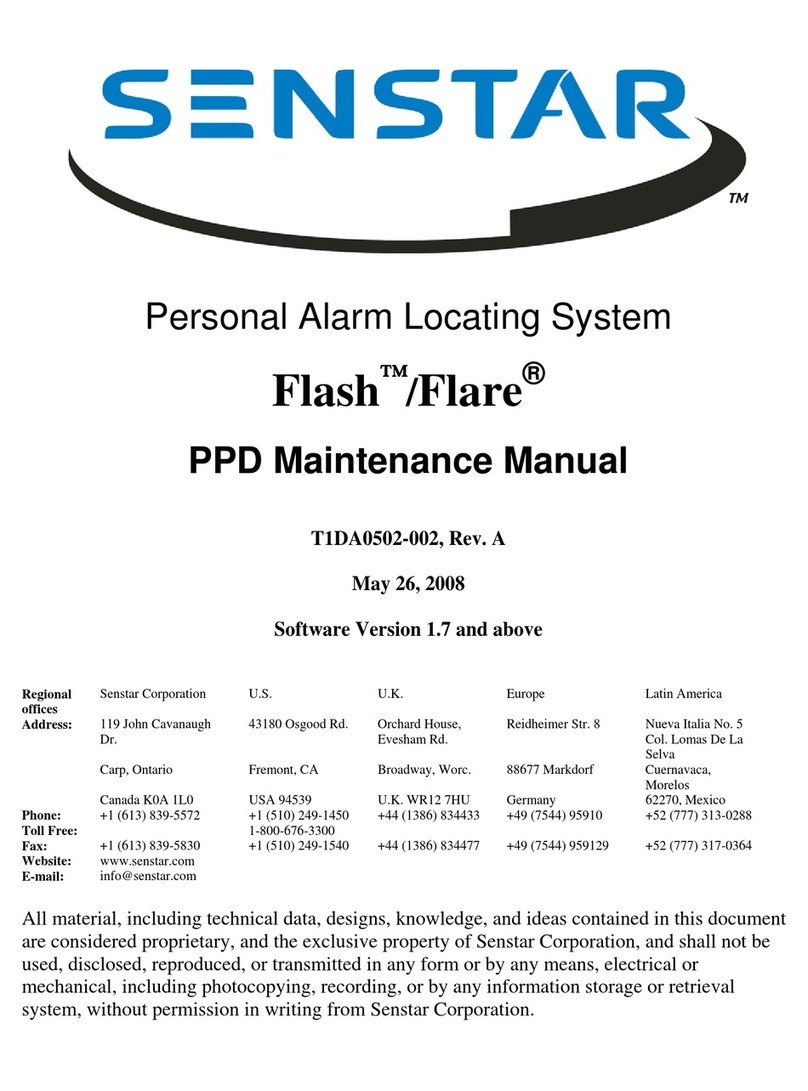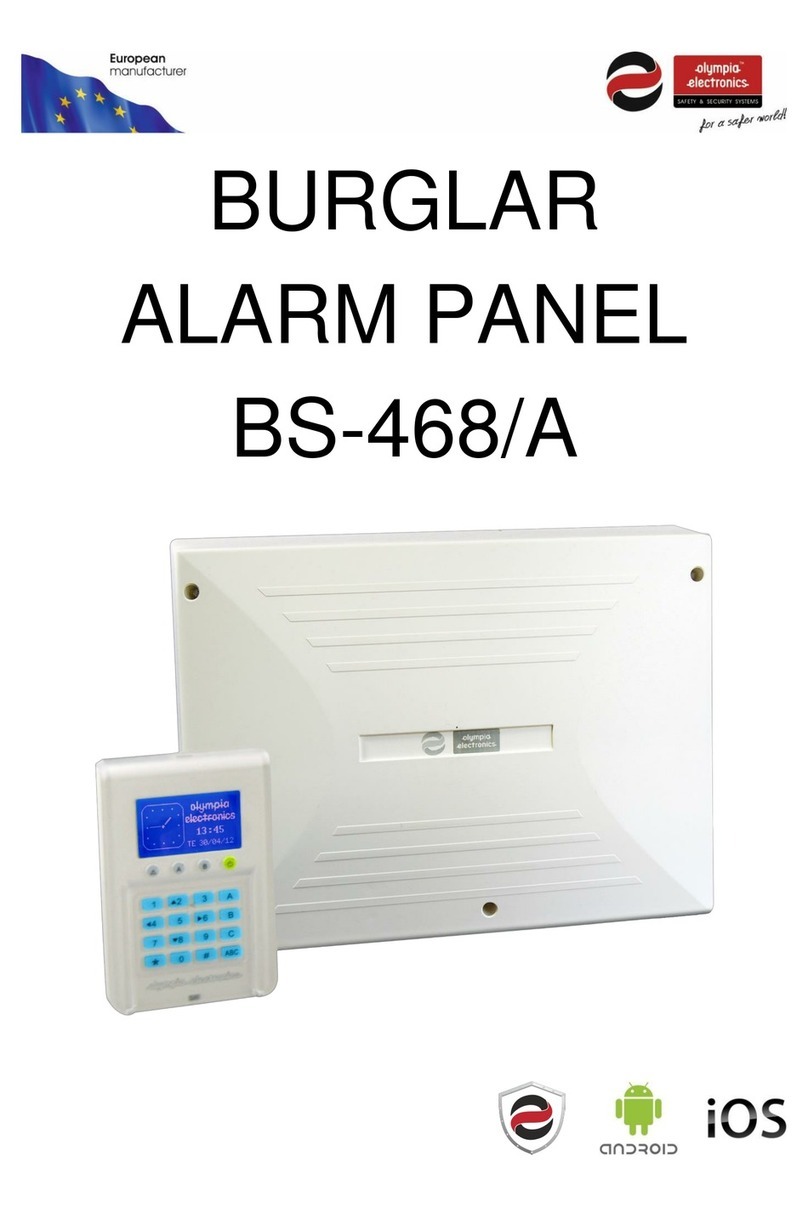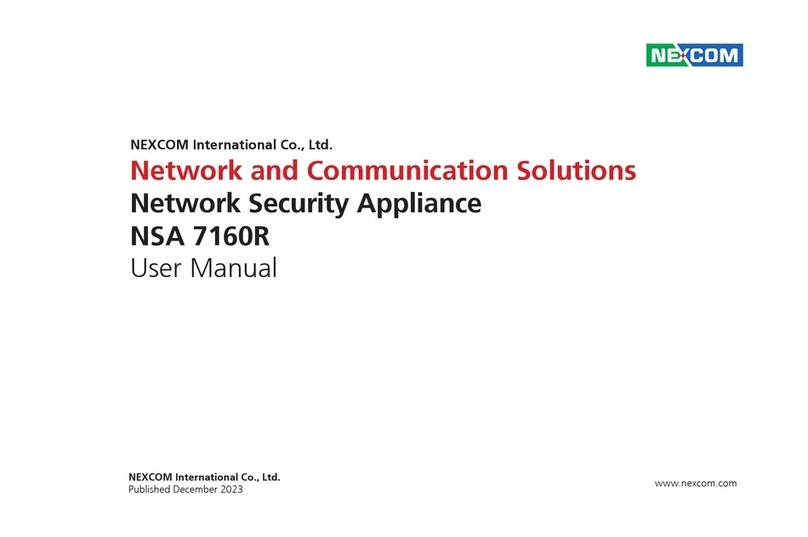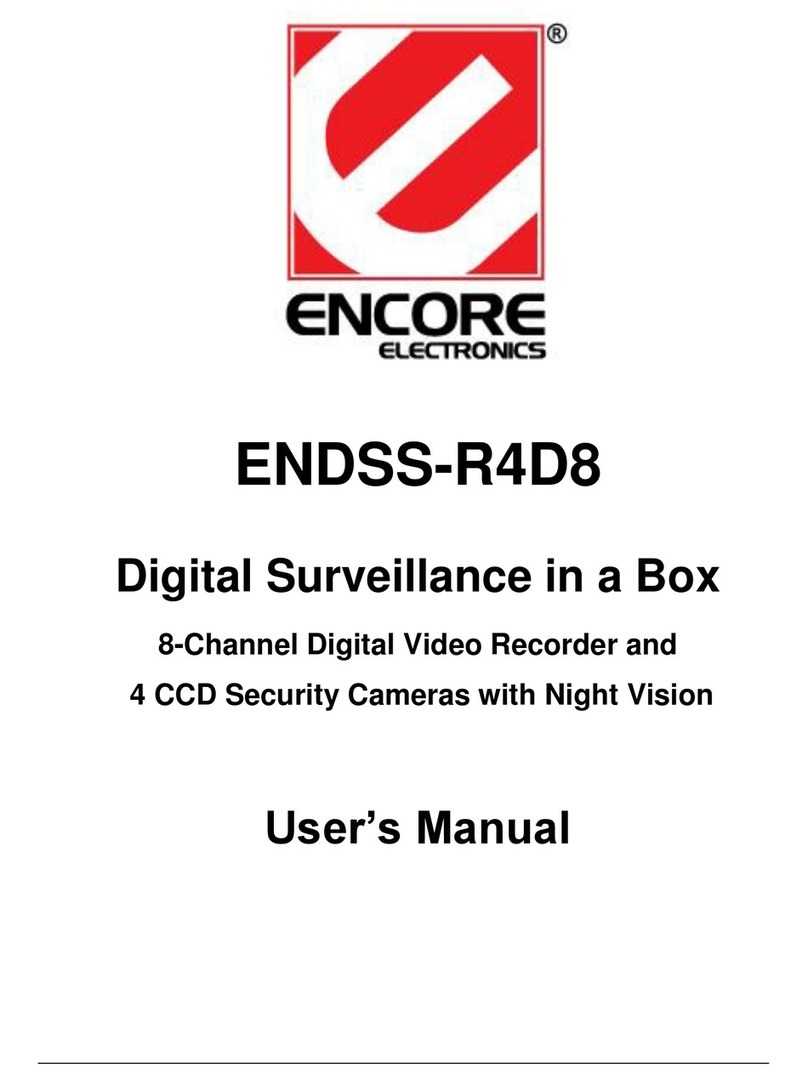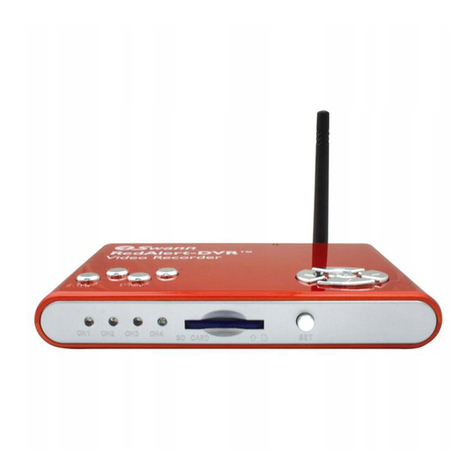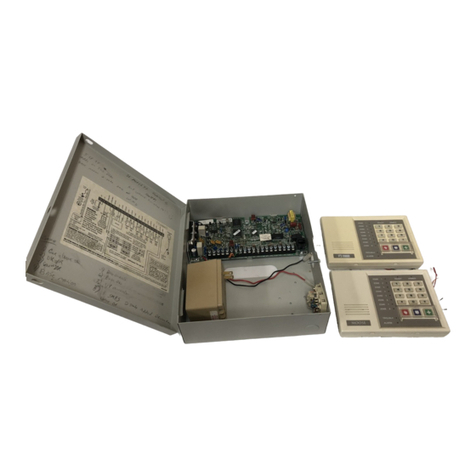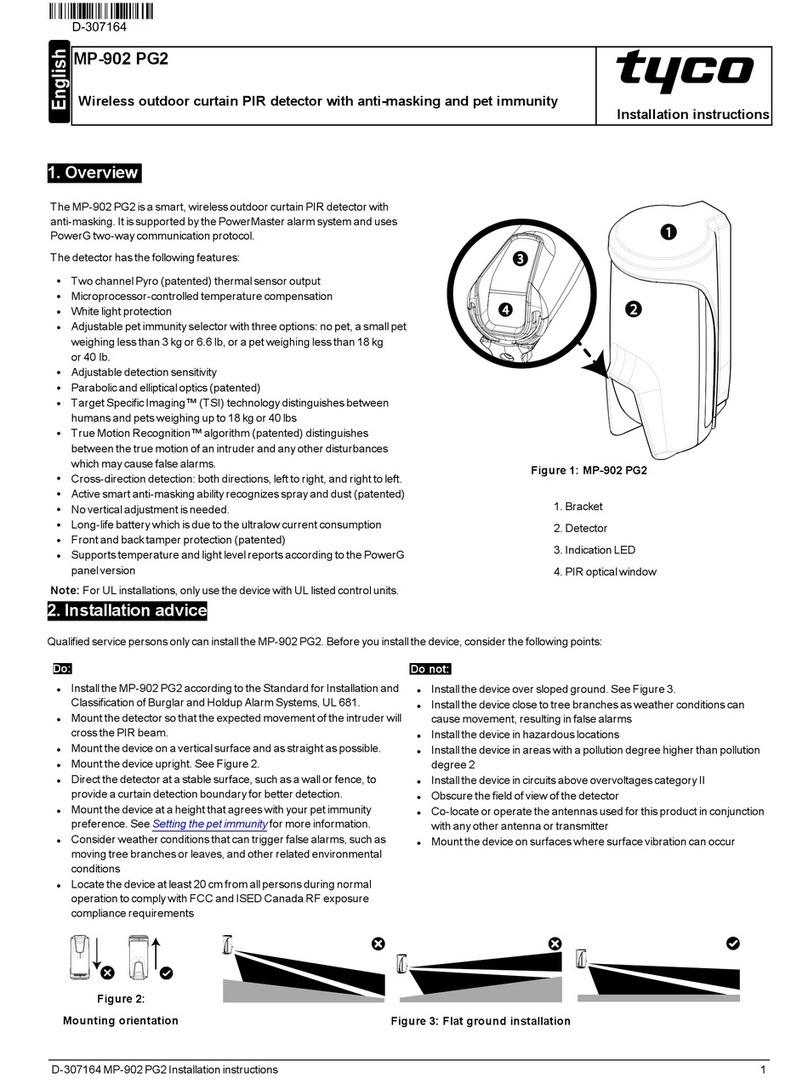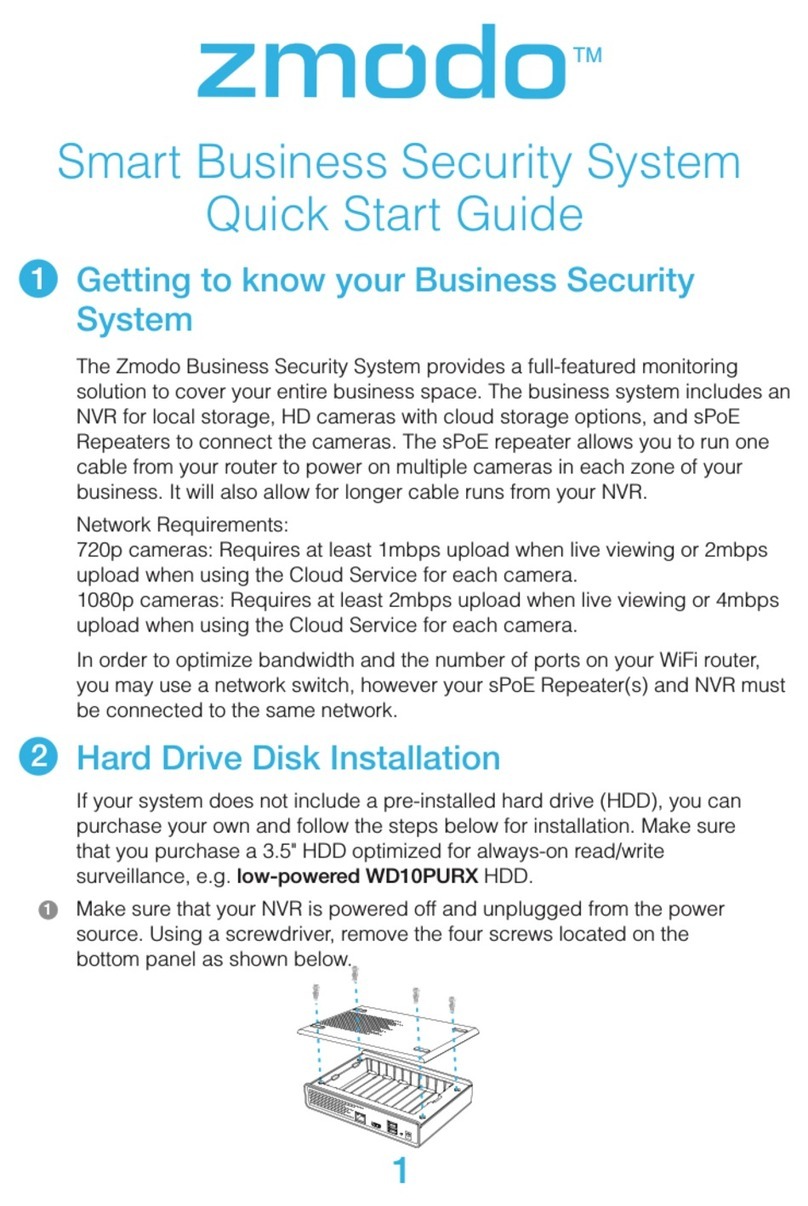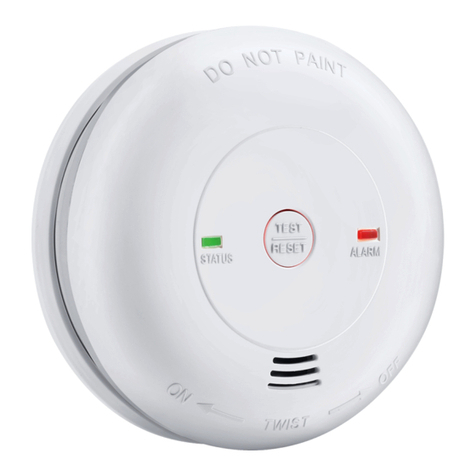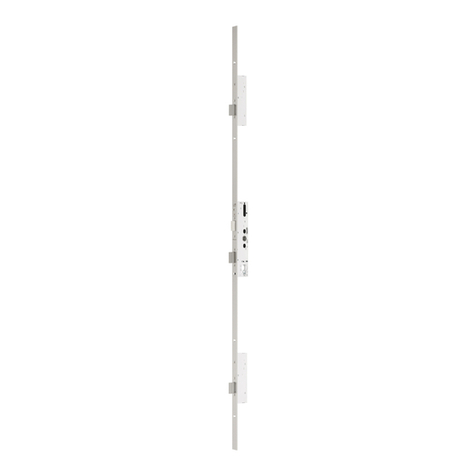SENSTAR Intelli-FLEX II User manual

Intelli-FLEX™II
Perimeter Protection System-Relay Output Processor
Product
Guide
C6DA0602-001, Rev K
First edition
October 9, 2008

Senstar Corporation
119 John Cavanaugh Road
Carp, Ontario
Canada K0A 1L0
Tel: +1 (613)-839-5572
Fax: +1 (613)-839-5830
Website: www.senstar.com
Email address: info@senstar.com
See back cover for regional offices.
C6DA0602-001, Rev K
First edition
October 9, 2008
Senstar is a registered trademark, and Intelli-FLEX and the Senstar logo are trademarks of Senstar Corporation. Product names
and Company names used in this manual are included for identification purposes only, and are the property of, and may be
trademarks of, their respective owners. Copyright © 2008, 2006, 2004, 2003, 2002, 1999 Senstar Corporation. All rights
reserved. Printed in Canada.
The information provided in this guide has been prepared by Senstar Corporation to the best of its ability. Senstar Corporation is
not responsible for any damage or accidents that may occur due to errors or omissions in this manual. Senstar Corporation is not
liable for any damages, or incidental consequences, arising from the use of, or the inability to use, the software and equipment
described in this guide. Senstar Corporation is not responsible for any damage or accidents that may occur due to information
about items of equipment or components manufactured by other companies. Features and specifications are subject to change
without notice. Any changes or modifications to the software or equipment that are not expressly approved by Senstar
Corporation void the manufacturer’s warranty, and could void the user’s authority to operate the equipment.
Senstar’s Quality Management System is IS0 9001:2000 registered.
Approvals
Canada: This Class B digital apparatus meets all requirements of the Canadian Interference -Causing Equipment Regulations.
Cet appareil numérique de la classe B respecte toutes les exigences du Règlement sur le matériel brouilleur du Canada.
USA: This device complies with part 15 of the FCC Rules. Operation is subject to the following two conditions: (1) This device may
not cause harmful interference, and (2) this device must accept any interference received, including any interference that may
cause undesired operation.
The use of shielded cables is required for compliance.
Any changes or modifications not expressly approved by Senstar Corporation could void the user’s authority to operate the
equipment.
Note: This equipment has been tested and found to comply with the limits for a Class B digital device, pursuant to part 15 of the
FCC Rules. These limits are designed to provide reasonable protection against harmful interference in a residential
installation.This equipment generates, uses and can radiate radio frequency energy and, if not installed and used in accordance
with the instructions, may cause harmful interference to radio communications. However, there is no guarantee that interference
will not occur in a particular installation. If this equipment does cause harmful interference to radio or television reception, which
can be determined by turning off and on, the user is encouraged to try to correct the interference by one or more of the following
measures:
- Reorient or relocate the receiving antenna.
- Increase the separation distance between the equipment and the receiver.
- Connect the equipment into an outlet on a circuit different from that to which the receiver is connected.
- Consult the dealer or an experienced radio/TV technician for help.
The use of shielded cables is required for compliance.

Intelli-FLEX IIproductguide • • • toc-1
Table of contents
1Overview
What is Intelli-FLEX II - - - - - - - - - - - - - - - - - - - - - - - - - - - - - - - - - - - - - - - - - - - - - - - - - 1-1
Purpose of this guide - - - - - - - - - - - - - - - - - - - - - - - - - - - - - - - - - - - - - - - - - - - - - - - - - - 1-2
2 Principles of operation
Adaptive signal processing - - - - - - - - - - - - - - - - - - - - - - - - - - - - - - - - - - - - - - - - - - - - - - 2-1
Intruder detection - - - - - - - - - - - - - - - - - - - - - - - - - - - - - - - - - - - - - - - - - - - - - - - - - - - - 2-2
System supervision - - - - - - - - - - - - - - - - - - - - - - - - - - - - - - - - - - - - - - - - - - - - - - - - - - - 2-3
3 System components
Standard components - - - - - - - - - - - - - - - - - - - - - - - - - - - - - - - - - - - - - - - - - - - - - - - - - 3-2
Optional components - - - - - - - - - - - - - - - - - - - - - - - - - - - - - - - - - - - - - - - - - - - - - - - - - - 3-7
4 Site planning
Site planning guidelines- - - - - - - - - - - - - - - - - - - - - - - - - - - - - - - - - - - - - - - - - - - - - - - - 4-1
Site Survey - - - - - - - - - - - - - - - - - - - - - - - - - - - - - - - - - - - - - - - - - - - - - - - - - - - - - - - - 4-2
Upgrade existing structures - - - - - - - - - - - - - - - - - - - - - - - - - - - - - - - - - - - - - - - - - - - - - - 4-3
Perimeter layout guidelines - - - - - - - - - - - - - - - - - - - - - - - - - - - - - - - - - - - - - - - - - - - - - 4-8
Equipment requirements - - - - - - - - - - - - - - - - - - - - - - - - - - - - - - - - - - - - - - - - - - - - - - 4-17
5 Installation instructions
Overview- - - - - - - - - - - - - - - - - - - - - - - - - - - - - - - - - - - - - - - - - - - - - - - - - - - - - - - - - - 5-1
Basic sensor cable installation - - - - - - - - - - - - - - - - - - - - - - - - - - - - - - - - - - - - - - - - - - - - 5-2
Cable installation on different fence types - - - - - - - - - - - - - - - - - - - - - - - - - - - - - - - - - - - - 5-9
Installation of cable at gates - - - - - - - - - - - - - - - - - - - - - - - - - - - - - - - - - - - - - - - - - - - - 5-13
Gate bypass module - - - - - - - - - - - - - - - - - - - - - - - - - - - - - - - - - - - - - - - - - - - - - - - - - 5-23
Cable devices - - - - - - - - - - - - - - - - - - - - - - - - - - - - - - - - - - - - - - - - - - - - - - - - - - - - - - 5-34
Installing the Intelli-FLEX II processor - - - - - - - - - - - - - - - - - - - - - - - - - - - - - - - - - - - - - - 5-37
Intelli-FLEX II processor settings- - - - - - - - - - - - - - - - - - - - - - - - - - - - - - - - - - - - - - - - - - 5-39

tableof contents
toc -2 • • • Intelli-FLEXII product guide
6 The Configuration module
Modes of operation - - - - - - - - - - - - - - - - - - - - - - - - - - - - - - - - - - - - - - - - - - - - - - - - - - - 6-2
7 System calibration
Connecting the Configuration module - - - - - - - - - - - - - - - - - - - - - - - - - - - - - - - - - - - - - - - 7-1
Configuration settings - - - - - - - - - - - - - - - - - - - - - - - - - - - - - - - - - - - - - - - - - - - - - - - - - 7-3
Zone profile evaluation - - - - - - - - - - - - - - - - - - - - - - - - - - - - - - - - - - - - - - - - - - - - - - - 7-10
a Maintenance/Troubleshooting
Maintenance - - - - - - - - - - - - - - - - - - - - - - - - - - - - - - - - - - - - - - - - - - - - - - - - - - - - - - - a-1
Troubleshooting - - - - - - - - - - - - - - - - - - - - - - - - - - - - - - - - - - - - - - - - - - - - - - - - - - - - - a-2
Supervision related problems - - - - - - - - - - - - - - - - - - - - - - - - - - - - - - - - - - - - - - - - - - - - a-3
Detection problems - - - - - - - - - - - - - - - - - - - - - - - - - - - - - - - - - - - - - - - - - - - - - - - - - - - a-7
False/Nuisance alarm problems - - - - - - - - - - - - - - - - - - - - - - - - - - - - - - - - - - - - - - - - - - a-10
Power problems - - - - - - - - - - - - - - - - - - - - - - - - - - - - - - - - - - - - - - - - - - - - - - - - - - - - a-12
Configuration module problems- - - - - - - - - - - - - - - - - - - - - - - - - - - - - - - - - - - - - - - - - - a-15
b Spare parts list
c Component specifications
Intelli-FLEX II Processor - - - - - - - - - - - - - - - - - - - - - - - - - - - - - - - - - - - - - - - - - - - - - - - - c-1
Gate bypass module - - - - - - - - - - - - - - - - - - - - - - - - - - - - - - - - - - - - - - - - - - - - - - - - - - c-2
Glossary
Index
Mark 2 sensor cable installation procedure
Introduction - - - - - - - - - - - - - - - - - - - - - - - - - - - - - - - - - - - - - - - - - - - - - - - - - - - - - - - - - -1
Cable stabilization procedure- - - - - - - - - - - - - - - - - - - - - - - - - - - - - - - - - - - - - - - - - - - - - - -1
Sensor cable installation guidelines - - - - - - - - - - - - - - - - - - - - - - - - - - - - - - - - - - - - - - - - - -2
Installation procedure - - - - - - - - - - - - - - - - - - - - - - - - - - - - - - - - - - - - - - - - - - - - - - - - - - -3
Adjusting low sensitivity detection spots - - - - - - - - - - - - - - - - - - - - - - - - - - - - - - - - - - - - - - - -4

Intelli-FLEX IIproduct guide • • • 1 - 1
1Overview
What is Intelli-FLEX II
Intelli-FLEX II is an outdoor perimeter intrusion detection sensor system. It
employs a passive coaxial cable detector, which is installed on the perimeter
fence, to detect intrusion attempts. The cables can sense any vibration along the
fence caused by climbing, cutting, or otherwise disturbing the fence fabric.
Each Intelli-FLEX II processor contains the electronics necessary to monitor one
or two sensor zones, and to report sensor alarms and supervision status via relay
contacts.
Features
•Easytoinstall
• Low cost, highly sensitive, consistent detection
• State of the art microcontroller-based processor
• User definable configuration parameters
• Detachable configuration module
• Discriminates between intrusion attempts and weather related events
• Lightning, EMI, and RFI protection
• Separate relay outputs for intrusion alarms and supervision in each zone
•Tampersensor
• AC-powered float charger - Provides 13.5 VDC to power processor and charge
battery (requires backup battery)
• 12 VDC Gel Cell backup battery - 8 hours of standby operation
• Wide voltage range DC/DC converter input for larger site installations

Purposeof this guide
1- 2 • • • Intelli-FLEX IIproductguide
Purpose of this guide
This is the product guide for the Intelli-FLEX II DC/DC powered relay output
processor. This guide includes information to assist you in selecting, installing,
calibrating and maintaining the components of your Intelli-FLEX II system.

Intelli-FLEX IIproduct guide • • • 2 - 1
2Principles of operation
The Intelli-FLEX II system uses a disturbance sensitive sensor cable to detect
intrusion attempts. The sensor cable acts as a distributed microphone along a
perimeter fence. It can be used as an alarm sensor, anywhere that there is
significant noise caused by an intrusion event.
Sensor cables, installed on an existing fence, detect vibrations in the fence fabric.
The signals generated by the vibrations are continually evaluated by the
Intelli-FLEX II processor to determine if an alarm should be generated.
The vibrations of the fence could be the result of the weather or they could be
caused by an intruder attempting to penetrate the perimeter by climbing over,
lifting, or cutting through the fence. The Intelli-FLEX II processor evaluates the
signals and discriminates between actual intrusion attempts and weather related
events.
The Intelli-FLEX II system monitors the processor’s power level. If there is a
significant fluctuation in the power, a supervision alarm will be generated.
In most applications, the processor can be programmed by the user for optimum
performance. In addition, the system firmware can be modified at the factory, for
unusual applications.
Adaptive signal processing
The Intelli-FLEX II system continuously monitors and evaluates signals from the
sensor cables. To avoid nuisance alarms, the system compensates for signals that
are picked up by the sensor cables due to wind and rain.

Intruder detection
2- 2 • • • Intelli-FLEX IIproductguide
Intruder detection
There are three basic intrusion attempt scenarios:
• Cut scenario - An intruder attempts to gain access to a secure area by cutting
the fence fabric until enough links have been separated to allow the intruder
to gain entry.
• Climb scenario variation 1 (climb-over) - An intruder attempts to gain access
to a secure area by climbing over the fence.
•Climbscenariovariation2(crawl-under) - An intruder attempts to gain access
to a secure area by lifting the fence fabric, and crawling under it.
The Intelli-FLEX II system recognizes these scenarios and can discriminate
between them and environmental activity.
Cutdetection
The processor detects an attempt to cut through the fence if:
• sensor cable stimulation exceeds the preset cut threshold parameter;
• the number of times that the cut threshold is exceeded is greater than the
preset cut count; and
• the preset cut count is exceeded within the preset cut window (time frame).
When the fence fabric is cut an impulse of energy produces a high initial
amplitude signal that exceeds the cut threshold. Each time the cut threshold is
exceeded a cut event is recorded. Cut activity will activate a cut counter. The cut
counter has a preset number of cuts that must occur within a preset time window
in order for the system to indicate that an intrusion attempt has occurred.
If the cut count is not exceeded within the preset time window, the counter
resets. If it is exceeded, the system identifies an intrusion attempt and will
generate a cut alarm.
Climbdetection
The processor detects an attempt to climb over or crawl under the security
perimeter if:
• sensor cable stimulation is sufficient to exceed the preset climb threshold
parameter;
• the climb threshold is exceeded for a preset cumulative period called the
climb time; and
• the climb time is accumulated within the preset climb window (time frame).

Systemsupervision
Intelli-FLEX IIproduct guide • • • 2 - 3
When an intruder attempts to climb over the fence, the action of feet and hands
pulling on and impacting the fence fabric, as well as strain in the fence fabric, will
cause a large number of energy pulses to rapidly occur. Pulling up on the fabric to
crawl under the fence creates a similar scenario. This type of contact with the
fence fabric will cause the preset climb threshold to be exceeded.
The initial contact will activate a climb time counter. The climb time counter
accumulates energy caused by climbing action. A preset number of climb contacts
must occur within a preset climb window time in order for the system to indicate
that an intrusion attempt has occurred.
If the climb activity count is not exceeded within the preset climb window the
climb counter resets. If the number is exceeded, the system identifies the activity
as an intrusion attempt and will generate a climb alarm.
System supervision
The Intelli-FLEX II system monitors itself to ensure that its protection capability is
not compromised. If that capability has been compromised, the system will
generate a supervision alarm. Supervision alarms can occur for several reasons:
• a sensor cable line supervision current fluctuation, which may indicate:
• sensor cable damage,
• a defective splice, or
• a defective terminator
• power failure, or low DC power
• processor enclosure door open
Unlike the intrusion alarm, which resets after detection, the supervision alarm
remains on until the problem is corrected.
Sensorcable linesupervision currentfluctuation
A terminator device is installed at the end of the sensor cable, to permit a small
DC supervision current throughout the entire length of the sensor cable. If the
current exceeds the defined limits, a supervision alarm will occur for that zone.

Systemsupervision
2- 4 • • • Intelli-FLEX IIproductguide
Damagedor defectivecomponents
A defect or cut in the sensor cable, non-sensitive feed cable, cable splice or
terminator will cause a supervision alarm.
If the terminator device is defective or damaged the supervision current will
fluctuate, causing a supervision alarm.
Powerfail
A voltage sensor monitors the internal 12 volt line and signals the system if the DC
voltage is too low. If the DC voltage drops, but remains above the low DC
threshold, the system will generate a power fail supervision alarm in both zones.
The system will maintain normal zone alarm detection capabilities while in this
condition.
LowDC voltageshutdown
When the DC voltage on the internal 12 volt line drops below the voltage
required to operate the system reliably (8 VDC), a low DC voltage condition
occurs. When this happens, the alarm and supervision relays for both zones
activate and the entire system shuts down. Once the DC voltage on the 12 volt
line increases to at least 11 VDC, the condition will clear and the system will
resume operation.
Tamper
The Intelli-FLEX II system uses a solid-state sensor to detect if the enclosure door
is open.
A magnet is mounted on a standoff on the enclosure door. The magnet must be
close to the tamper sensor located on the processor for the tamper alarm to be
deactivated. When the enclosure door is opened the magnet is moved away from
the sensor. This action causes a supervision alarm to occur in the zones that are
connected to the processor. The system will maintain normal zone alarm
detection capabilities while in this alarm condition.
Refer to Appendix a - Troubleshooting, Tamper Supervision for instructions on
clearing tamper alarms.

Intelli-FLEX IIproduct guide • • • 3 - 1
3System components
Figure 3-1 Intelli-FLEX II system diagram
Each Intelli-FLEX II system is a self contained detection system.
The basic Intelli-FLEX II system requires the following
components:
The following optional components can be added to
the basic system:
• Intelli-FLEX II dual zone
processor
• cable splice kit • sliding gate disconnect assembly
• tie wraps • gate bypass module
• sensor cable • enclosure
• non-sensitive feed cable • power supply
• cable terminator kit • configuration module
(order separately)
Zone 1
Zone 2
Cut
Climb
Time Window
Threshold
Cut Count
Climb Time
Display
Select
Increase
Decrease
Load /
Self Test
Configure
Monitor
Mode
Select
Alarm
Supervision
Clear
Level
Relay Time
Cut Profile
Peak Trigger
Ambient Comp
Common Mode
Function
Select
Intelli-FLEX™
zone 2
zone 1
dual zone processor
24 VDC gel-cell battery
& float charger
(optional) configuration module
sensor cable
non-sensitive feed cable
cable terminator
cable splice
At least one Configuration
module is required at each
installation for system
configuration and
calibration.

Standardcomponents
3- 2 • • • Intelli-FLEX IIproductguide
Standard components
Dualzone processor
Figure 3-2 Dual zone processor
The Intelli-FLEX II dual zone processor contains the circuitry necessary to
monitor one or two independent sensor zones. Generally, these two zones are
located beside each other. When used to monitor two zones, the Intelli-FLEX II
dual zone processor is capable of monitoring 610 meters (2,000 ft.) of sensor
cable, 305 meters (1,000 feet) per zone. For a single cable pass installation, with
service and corner loops included, this means that approximately 575 m (1885 ft.)
of fence can be monitored by one dual zone processor.
Non-sensitive feed cables are spliced together with the sensor cables and
connected to the processor at the F-connectors located at the top of the processor
card.
The terminal blocks along the bottom of the processor card contain connection
capacity for the processor power supply, alarm monitoring/reporting systems.
Corresponding LEDs indicate supervision and intrusion alarms for both zones 1
and 2, and system power on status.

Standardcomponents
Intelli-FLEX IIproduct guide • • • 3 - 3
A plug-in connector allows you to connect the configuration module to the
processor.
Intelli-FLEX II processors containing relay outputs can be used with existing
E-Flex sensor cable installations. They can replace existing EIIA, EIIAHR, EIIB,
EIIBHR and E3i processors.
Sensorcables
Intelli-FLEX sensor cables are sensitive to physical disturbance. Because they are
mounted directly on existing fences, anything that causes the fence fabric to
vibrate, such as shaking or hitting the fence, will be transferred to the sensor
cable.
These disturbances generate electronic signals that are representative of the fence
activity. The signals are passed from the sensor cables to the processor where they
are analyzed.
Non-sensitivefeed cable
The non-sensitive coaxial feed cable does not detect vibrations. It is used
primarily in two instances. In both cases, the non-sensitive feed cable allows the
signals that are generated through the sensor cable to be routed to the processor.
The sensor cable cannot be connected directly to the processor, therefore, a
section of non-sensitive feed cable, complete with an F-connector, is spliced to
the end of the sensor cable. The feed cable is then connected to the processor at
the F-connector.
The non-sensitive feed cable is also used to bypass gates or buildings. This is
accomplished by splicing a section of the feed cable to the sensor cable zone at
the location of the gate or building.
The input power of the Intelli-FLEX II processor may be different
from the existing one. Be sure to use the new power transformer. If
you are using distributed power, consult Senstar to determine the
compatibility with existing installations.
Caution

Standardcomponents
3- 4 • • • Intelli-FLEX IIproductguide
Cableterminator
Figure 3-3 Cable terminator
The cable terminator is a moisture proof termination device that enables the
supervision current to pass through the sensor cable. It is installed at the end of
the sensor cable away from the processor.
Cablesplice
Figure 3-4 Cable splice
The cable junction device is a moisture proof splice kit. It is used to splice
non-sensitive feed cable to sensor cable, or to connect two pieces of sensor cable
together.

Standardcomponents
Intelli-FLEX IIproduct guide • • • 3 - 5
Tiewraps
UV-resistant nylon tie wraps are used to secure the cables, cable terminator and
cable splice kits to the fence fabric.
Configurationmodule
Figure 3-5 Configuration module
A detachable configuration module enables the operator to monitor the system
operation and response, and to view or change the system configuration.
Powersupplyoptions
The Intelli-FLEX II DC/DC dual zone processor can be powered one of two ways:
• DC power/float charger and rechargeable battery
• a centrally located low voltage DC power source (18 to 56 VDC)
DC power/float charger and rechargeable battery
The DC power/float charger is the most feasible option when AC power is
convenient and the AC power receptacle is protected from the weather. The DC
power/float charger is merely plugged into the AC power source and 12 VDC is
applied to the processor in parallel with a 12 VDC Gel Cell battery. This is often
the best case for small installations that involve one or two processors. The DC
power/float charger is capable of supplying 12 VDC to the processor, and
charging the 12 volt Gel Cell Battery. A battery must be located at each processor
or at the DC power/float charger.
Cut
Increase
Decrease
Mode
Select
Clear
Level
Peak Trigger
Function
Select

Standardcomponents
3- 6 • • • Intelli-FLEX IIproductguide
Centrally located low voltage DC power source
A centrally located low voltage DC power source is more appropriate when
multiple processors are to be deployed around a larger perimeter, or where the
power run to even a single processor exceeds several meters (a few hundred
feet). This option allows DC power to be conveniently distributed from a central
power source to all processors and other equipment around a perimeter. In this
configuration, a DC power supply may be located indoors, and the 24 VDC
output, (48 VDC in large installations), is run along the perimeter to each of the
Intelli-FLEX II processors. The central DC power supply may be plugged into a
readily accessible UPS system to provide additional isolation and a non-
interruptible source of power.
The DC/DC converters on the processor boards accept a wide input voltage range
(18 to 56 VDC) and produce a regulated +12 VDC output voltage. Thus, large
voltage drops in the distribution system are not a problem. The distribution
voltage around the perimeter is also isolated from the output of the converter on
the processor to protect the processor from electrical surges.
Backup power (UPS)
When the central low voltage power supply is used, it should be powered from a
non-interruptible source of AC power. This power source will usually be provided
for the computer system that is often a part of larger installations, or will be part
of a UPS system for the overall security system. If a UPS system is not already a
part of the overall security installation, a small standalone UPS system may be
used to power the Intelli-FLEX II perimeter system. The UPS system may be
purchased from a local supplier or from Senstar.
Each Intelli-FLEX II processor requires approximately 1 watt of power, making the
total power consumption of even large systems very small. A small UPS system
that is designed to run a personal computer system (typically 300 watts) for 15 or
20 minutes will power an Intelli-FLEX II perimeter system for several hours.
Enclosure
The fibreglass NEMA 4 rated weatherproof enclosure provides a protective
covering for the processor. The processor circuit board is mounted on a metal
plate, inside the enclosure. There are two cable entry ports on the bottom of the
enclosure for the sensor cables, alarm communication wiring, and power &
ground cables. The enclosure measures 34.8 cm h X 30 cm w X 17.3 cm d (13.7
in. X 11.8 in. X 6.8 in.) and includes four mounting feet. The enclosure can be
mounted on a wall, or other flat stable surface, located close to the sensor zone.

Optionalcomponents
Intelli-FLEX IIproduct guide • • • 3 - 7
Optional components
Slidinggate disconnectassembly
The sliding gate disconnect assembly is used to provide security across a sliding
gate within an Intelli-FLEX II zone that is not frequently used. With this device the
gate may be left securely unattended, however, the gate can be opened and closed
by manually separating the connection to open the cable line. A supervision alarm
is generated when the cable line is opened.
Gatebypassmodule
The Intelli-FLEX Gate bypass module is used to bypass a protected gate without
triggering an intrusion alarm.
The module operates in secure and access modes. When the unit is in secure
mode, the gate is monitored by the system. It acts as any other section of
protected fence and an alarm triggers whenever an intrusion attempt occurs. In
access mode the gate is unprotected, hence no alarm is triggered when the gate is
used.
Figure 3-6 Sliding gate disconnect assembly
disconnect
assembly
weather boot
hose clamp

Optional components
3- 8 • • • Intelli-FLEX IIproductguide
Two options of the gate bypass module are available:
• Model 2490-1 - manual (or local) operation (keylock switch)
• Model 2490-2 - remote operation (remote-controlled relay).
Figure 3-7 Local and remote gate bypass modules
MODEL 2490-2
Local gate bypass module Remote gate bypass module
SECURE ACCESS
MODEL 2490-1

Intelli-FLEX IIproduct guide • • • 4 - 1
4Site planning
Site planning guidelines
Follow these guidelines to create an operating environment that allows the
Intelli-FLEX II system to perform well. Perform regular inspections to ensure that
the fence remains in good condition. Timely repairs to fence damage, the control
of vegetation, and regular visual inspections of all detection zones, will provide
years of effective operation.
Site planning includes four main steps. These steps will be detailed in the
following sections:
For installation guidelines refer to Chapter 5, Installation instructions.
survey site Site Survey on page 4-2
upgrade existing structures
as necessary Upgrade existing structures on page 4-3
layout components on site
plan in accordance with
guidelines
Perimeter layout guidelines on page 4-8
determine equipment
requirements Equipment requirements on page 4-17

SiteSurvey
4- 2 • • • Intelli-FLEX IIproductguide
Site Survey
A survey should be conducted before installing any system hardware to ensure
that the site conditions are suitable for optimum function of an Intelli-FLEX II
system. The primary concern of the site survey is the condition of the fences and
gates where the sensor cable will be attached.
When conducting the site survey indicate the following on the site plan:
• locations of existing structures (include fences, gates, buildings, etc.) Check
that the mounting surfaces are in compliance with established standards with
respect to stability.
• location of obstacles such as vegetation.
Figure 4-1 Sample site plan
Z1 Z2
Z3
Z4
Z5
Z6
Z7
Z8
Z9
proc #4
proc #1
proc #2
proc #3
terminator (typical)
sally port gate
(included in Z6)
microwave
sensors main
building
swinging gate
(included in Z3)
NOTE:
not required
gate disconnect
- extra sensor cable at corner poles
service
loops
- drip loops at each splice/termination
sally port
gate
end of zone overlap
(approx. 1.5 m (5 ft.))
Also required at start points
max 290 m (950 ft.)
non-sensitive feed cable
(typical)
- service loops
gate disconnect
Table of contents
Other SENSTAR Security System manuals
Popular Security System manuals by other brands

Safety Link
Safety Link GO Trek quick start guide
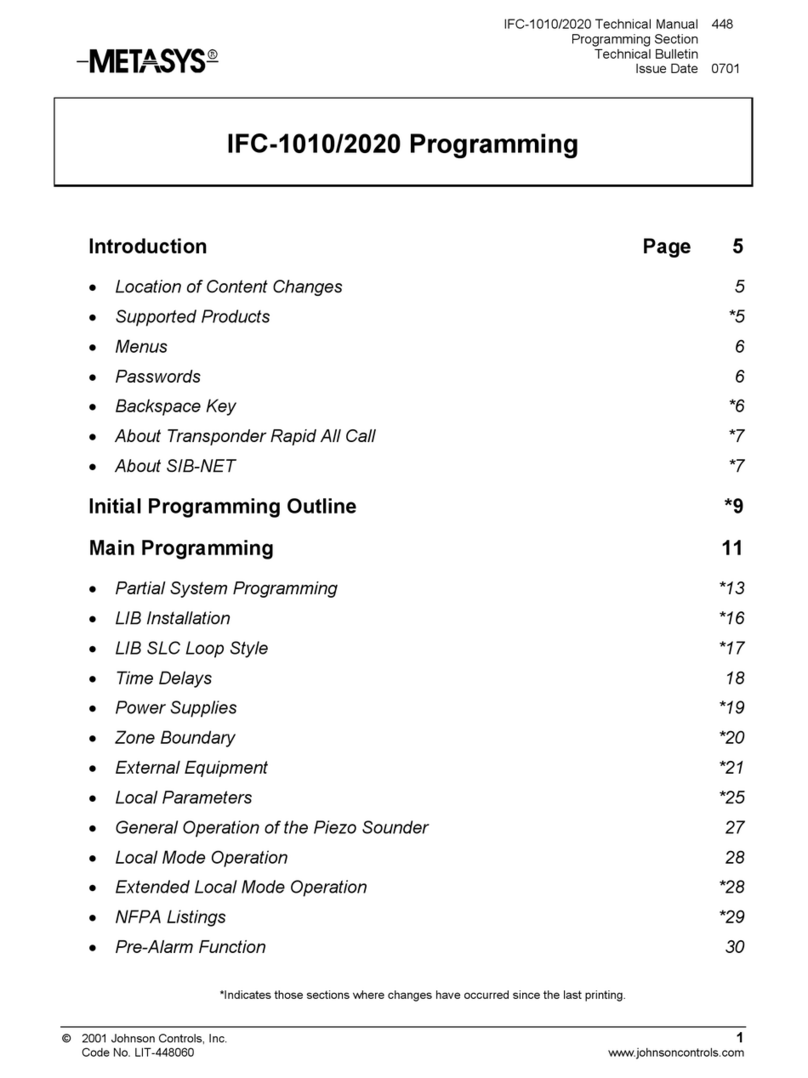
Metasys
Metasys IFC-1010 Technical Manual Programming Section
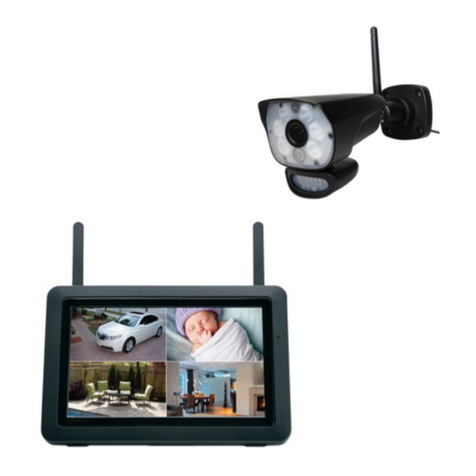
ELRO
ELRO CZ60RIP11S manual

Buffalo
Buffalo LinkStation HD-H120LAN user manual

Wireless Alarms
Wireless Alarms S100KP Installation and operating instructions
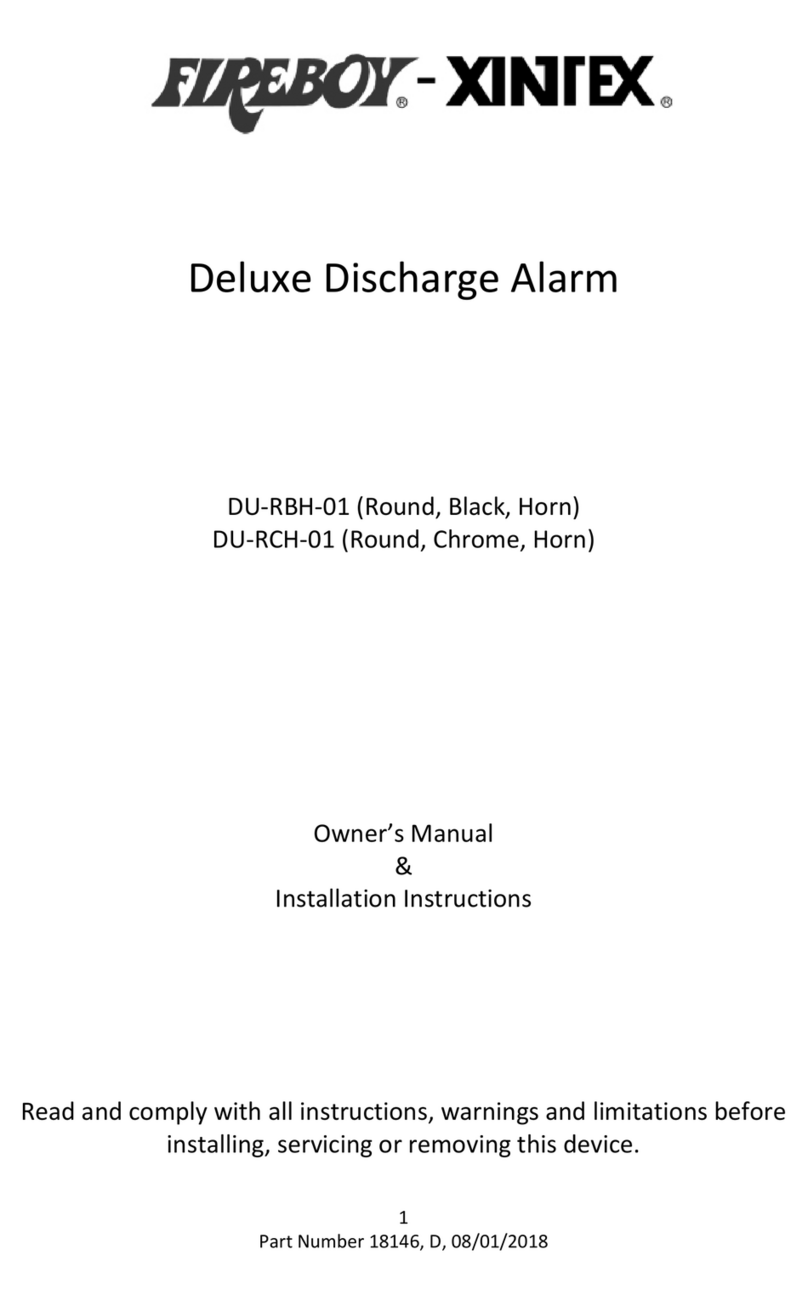
Fireboy- Xintex
Fireboy- Xintex DU-RBH-01 Owner's Manual & Installation Instructions

